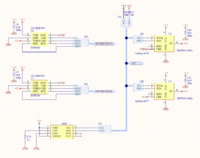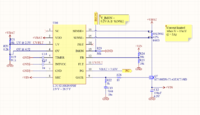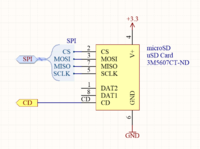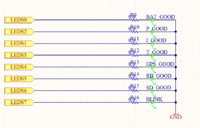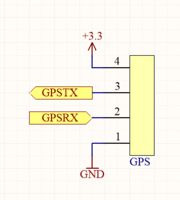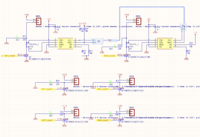Difference between revisions of "Balloon Gen 1 Avionics"
| Line 42: | Line 42: | ||
The RockBlock was included in the core avionics as a vital part of any avionics suite -- the ability to both transmit and receive data being a fundamental part of any suite. | The RockBlock was included in the core avionics as a vital part of any avionics suite -- the ability to both transmit and receive data being a fundamental part of any suite. | ||
| + | |||
| + | The power circuits, designed by Sasha Maldonado, provided for battery protection and 5V boost capability. The battery pack contained no on-board BMS -- all relevant circuits were integrated into the avionics. | ||
| + | |||
| + | Pinouts were provided for I2C, SPI, as well as VIN, 3.3V, 5V, and GND to allow for the extension of the avionics with additional sensors or other auxiliary features. | ||
| + | |||
| + | == Schematics == | ||
| + | |||
| + | <gallery widths=200px heights=200px> | ||
| + | File:Oscar_top.PNG | <center> Top Sheet </center> | ||
| + | File:Oscar_thermocouple.PNG | <center> Thermocouple Sheet </center> | ||
| + | File:Oscar_sensors.PNG | <center> Sensors Sheet </center> | ||
| + | File:Oscar_rtc.PNG | <center> RTC Sheet </center> | ||
| + | File:Oscar_rb.PNG | <center> RockBlock Sheet </center> | ||
| + | File:Oscar_protector.PNG | <center> Battery Protector Sheet </center> | ||
| + | File:Oscar_pinouts.PNG | <center> Pinouts Sheet </center> | ||
| + | File:Oscar_multiplexer.PNG | <center> Multiplexer Sheet </center> | ||
| + | File:Oscar_microsd.PNG | <center> MicroSD Sheet </center> | ||
| + | File:Oscar_leds.PNG | <center> LEDs Sheet </center> | ||
| + | File:Oscar_gps.PNG | <center> GPS Sheet </center> | ||
| + | File:Oscar_fets.PNG | <center> FETs Sheet </center> | ||
| + | File:Oscar_boost.PNG | <center> 5V Boost Sheet </center> | ||
| + | </gallery> | ||
Revision as of 15:21, 27 August 2016
The Balloons Gen 1 Avionics Platform is the first core avionics suite developed by HABEES. Named Oscar, this avionics suite flew on a failed technology demonstration in SSI-39, followed by a successful demonstration in SSI-40. As the first core avionics suite, it set the expectations for features to be included in subsequent revisions.
The full list of features found on Oscar:
- Teensy 3.2 Main MCU
- Five total pressure/temperature sensors, including two BMP280's, two MS5803's, and one MPL3115A2
- Micro SD card data logging
- Real Time Clock with backup battery
- Thermocouple for external temperature sensing
- uBlox NEO-6M GPS
- 6 custom-use MOSFET's
- Current sensing on two MOSFET's
- Indicator LED's for flight critical states
- Battery Protection (OV/UV/OC)
- 5V Battery Boost
- RockBlock Satellite Communications
- Pinouts for I2C, SPI, Power
Design
Oscar was designed around the concept of meeting core HAB flight requirements -- nothing more and nothing less. Thus, the key elements of a HAB flight were considered to be: internal temperature, altitude, external temperature, location, data logging, cutdown/heating, satellite communications, and state indication.
A total of five pressure/temperature sensors were selected, from three different varieties. The inspiration for this was robust fusion across slightly different sensors with various resolutions and accuracies. Further, ValBal maintained a history of fusing multiple pressure sensors, and this was used as inspiration for core avionics.
A NEO-6M GPS was chosen as the primary GPS unit due to its low cost ($20 compared to previously used GPS's such as the Adafruit GPS which cost $50), proven reliability, and attachable antenna.
An IC2 Multiplexer (The MCP23017) was chosen to control both the custom-use MOSFET's and indicator LED's so as to not utilize capable Teensy pinouts for mundane purposes. A total of eight indicator LED's were driven by the multiplexer, as well as all six MOSFET's. At the time of brainstorming, the suggested LED-indicated states included the following: Pressure In Range, Temperature In Range, SD Good (logging), GPS Good (has lock), RB Good (transmitting), Battery Good (in voltage), Current Good (in range), Power Good (protector not enabled), and heartbeat BLINK.
A thermocouple was included on Oscar as "outside temperature" began to be considered critical flight information. A thermocouple had only been flown in the Core Avionics POC before, but had been considered of reasonable utility and having numerous applications for further research projects and avionics expansions.
An RTC was included to be able to log data with timestamps to allow post-analysis simpler and reduce burden on "syncing" up times from the data log to the launch. The SD data logging accompanies all balloon flights for logging of core data.
The RockBlock was included in the core avionics as a vital part of any avionics suite -- the ability to both transmit and receive data being a fundamental part of any suite.
The power circuits, designed by Sasha Maldonado, provided for battery protection and 5V boost capability. The battery pack contained no on-board BMS -- all relevant circuits were integrated into the avionics.
Pinouts were provided for I2C, SPI, as well as VIN, 3.3V, 5V, and GND to allow for the extension of the avionics with additional sensors or other auxiliary features.


